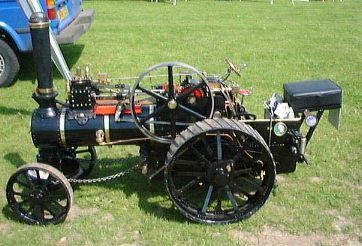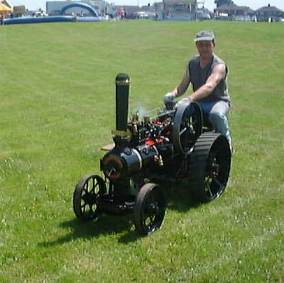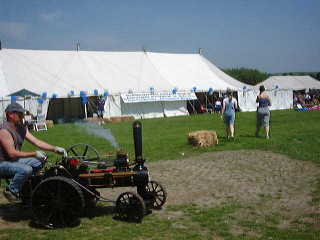WORTLEY TOP
FORGE MODEL ENGINEERS
"ANNIE" - A 4" Scale Fowler Traction Engine
By Eric
Wilson
 It was back
in 1996 when a friend of mine brought Ray Waller along to my workshop to look
at my model of a Fowler steam engine. Ray had nearly completed a model which
was very similar to mine, and it soon became clear that we both shared the same
range of interests in both modelling and prototypes - notably Fowler’s
Traction Engines. “If I wa’ twenty year younger, we could have
built a big’un apiece”, mused Ray with just a hint of regret for
the passing years. A few months passed, when the phone rang and there was Ray
again! “Does tha’ fancy building a 3” Fowler, Eric? I’ll
do thee drawings an’ give thee a hand wi’ it!” I said I
would think it over ....... and was doing just that when a few days later, Les
Donn popped round. I told Les what Ray had suggested expecting him to tell me
to forget it. Far from it! “Nay! If tha’s going to make one, make
it a 4-incher. Thee can sit on ‘er and ride it round if it’s a big
‘un”! Not only did I suddenly realise that Les wasn’t
joking, but the vision of driving the beast around actually clinched it for me.
I just had to have a go! I promptly phoned Ray and said that if I could get a
cylinder block cast, I was game for it. I duly set about making a pattern which
I then took down to the Forge and showed the lads. Heads were shaking and some
claimed that it wouldn’t work. “It’ll never come out of the
sand clean”; “Look at those lugs and bosses”; “You’ve
nay chance, lad”. A bit disillusioned, I took the pattern round to a
pal who happens to be a precision moulder. “Could tha’ make that,
Peter”? “Nay bother” came the quick reply ...............
And that’s where it all began.
It was back
in 1996 when a friend of mine brought Ray Waller along to my workshop to look
at my model of a Fowler steam engine. Ray had nearly completed a model which
was very similar to mine, and it soon became clear that we both shared the same
range of interests in both modelling and prototypes - notably Fowler’s
Traction Engines. “If I wa’ twenty year younger, we could have
built a big’un apiece”, mused Ray with just a hint of regret for
the passing years. A few months passed, when the phone rang and there was Ray
again! “Does tha’ fancy building a 3” Fowler, Eric? I’ll
do thee drawings an’ give thee a hand wi’ it!” I said I
would think it over ....... and was doing just that when a few days later, Les
Donn popped round. I told Les what Ray had suggested expecting him to tell me
to forget it. Far from it! “Nay! If tha’s going to make one, make
it a 4-incher. Thee can sit on ‘er and ride it round if it’s a big
‘un”! Not only did I suddenly realise that Les wasn’t
joking, but the vision of driving the beast around actually clinched it for me.
I just had to have a go! I promptly phoned Ray and said that if I could get a
cylinder block cast, I was game for it. I duly set about making a pattern which
I then took down to the Forge and showed the lads. Heads were shaking and some
claimed that it wouldn’t work. “It’ll never come out of the
sand clean”; “Look at those lugs and bosses”; “You’ve
nay chance, lad”. A bit disillusioned, I took the pattern round to a
pal who happens to be a precision moulder. “Could tha’ make that,
Peter”? “Nay bother” came the quick reply ...............
And that’s where it all began.
 Ray and I
set ourselves a target; it had to be running for the millennium which gave us
about three years. Ray had a set of drawings for a 1909 Fowler 2” scale
single-cylinder engine. While Ray set about doubling up all the measurements
and producing the new set of drawings, I started to think about making the
patterns for the castings, including one for an 18” diameter fly-wheel
with six spokes. This alone took a whole week to make. All of the patterns were
made from MDF - it’s marvellous stuff for this kind of job. The front
wheels were of 15” diameter, while the rear wheels were a massive
24”, and proved to be the most laborious job with 220 rivets needed for
each! My milling machine was pushed well beyond its limits when machining up
the cylinder block! The bore is 2 5/8” X 4” stroke. All of the gears
needed cutting. These included the differential and the final drive gear which
is 18” in diameter and has 72 teeth. I definitely used some set-ups which
have not appeared in any text book! There are two start worm gears on the
steering assembly, which does make steering much easier. The crank shaft is a
casting made in S.G. iron for strength. There are over 1000 rivets in total,
whilst all nuts and bolts are metric. The radius on the tender was made from a
2” pipe cut lengthways into four. (An idea I found in Model Engineer).
Phil Moisely did a great welding job - not a joint in sight! I then
fibre-glassed the inside to help prevent rusting. The spud pan which fits
beneath the front axle was made from the top of a propane gas bottle which is
perfect for the job ..... but cutting it required several pints of sweat! The
winch has 20yds of wire rope on it. The only part which we couldn’t make
was the flywheel ....... And this was where we called on Les Donn who came up
with the goods for us. And a smashing job he’s made of it!
Ray and I
set ourselves a target; it had to be running for the millennium which gave us
about three years. Ray had a set of drawings for a 1909 Fowler 2” scale
single-cylinder engine. While Ray set about doubling up all the measurements
and producing the new set of drawings, I started to think about making the
patterns for the castings, including one for an 18” diameter fly-wheel
with six spokes. This alone took a whole week to make. All of the patterns were
made from MDF - it’s marvellous stuff for this kind of job. The front
wheels were of 15” diameter, while the rear wheels were a massive
24”, and proved to be the most laborious job with 220 rivets needed for
each! My milling machine was pushed well beyond its limits when machining up
the cylinder block! The bore is 2 5/8” X 4” stroke. All of the gears
needed cutting. These included the differential and the final drive gear which
is 18” in diameter and has 72 teeth. I definitely used some set-ups which
have not appeared in any text book! There are two start worm gears on the
steering assembly, which does make steering much easier. The crank shaft is a
casting made in S.G. iron for strength. There are over 1000 rivets in total,
whilst all nuts and bolts are metric. The radius on the tender was made from a
2” pipe cut lengthways into four. (An idea I found in Model Engineer).
Phil Moisely did a great welding job - not a joint in sight! I then
fibre-glassed the inside to help prevent rusting. The spud pan which fits
beneath the front axle was made from the top of a propane gas bottle which is
perfect for the job ..... but cutting it required several pints of sweat! The
winch has 20yds of wire rope on it. The only part which we couldn’t make
was the flywheel ....... And this was where we called on Les Donn who came up
with the goods for us. And a smashing job he’s made of it!
“Annie”
eventually took shape. She stands 4’ high and is some 6’ long by
30” wide. She has two speeds and will run along happily at 5-6 mph with a
water capacity of four gallons. All-up weight is around 10cwt. I’d always
said I wanted to go the whole hog and register “Annie” for the road,
so she’s now taxed and fully insured. I reckon she’s the first new
Fowler traction engine registered in Sheffield for 70 years! It’s a
wonderful feeling when steaming up, and then chugging along the public highway!
It always causes quite a stir and people like to stop and ask all kinds of
questions about her. So far, she’s run up about 50 hours in steam and I am
just now putting the finishing touches to her - things like the lining and
other decorative touches. Her first public outing in steam was at Kelham Island
Museum in May 2000. They were so impressed with it that they have now acquired
an engine of a similar size for giving public rides around their museum site.
Prior to this, we had taken “Annie” as one of Wortley’s exhibits
at the annual Rotherham MES show in March. I cannot finish without thanking all
the lads who have helped with Annie, whether it be the loan of tools and
‘bits and bobs’, and especially Ray Waller for the many hours spent
drawing, marking out and machining. I really enjoyed the time we spent
scratching our heads and seeing the final result in all her glory! Finally,
special thanks must go to Ann(ie) and Marge for their support and their
tolerance!
Return to Projects Page

 It was back
in 1996 when a friend of mine brought Ray Waller along to my workshop to look
at my model of a Fowler steam engine. Ray had nearly completed a model which
was very similar to mine, and it soon became clear that we both shared the same
range of interests in both modelling and prototypes - notably Fowler’s
Traction Engines. “If I wa’ twenty year younger, we could have
built a big’un apiece”, mused Ray with just a hint of regret for
the passing years. A few months passed, when the phone rang and there was Ray
again! “Does tha’ fancy building a 3” Fowler, Eric? I’ll
do thee drawings an’ give thee a hand wi’ it!” I said I
would think it over ....... and was doing just that when a few days later, Les
Donn popped round. I told Les what Ray had suggested expecting him to tell me
to forget it. Far from it! “Nay! If tha’s going to make one, make
it a 4-incher. Thee can sit on ‘er and ride it round if it’s a big
‘un”! Not only did I suddenly realise that Les wasn’t
joking, but the vision of driving the beast around actually clinched it for me.
I just had to have a go! I promptly phoned Ray and said that if I could get a
cylinder block cast, I was game for it. I duly set about making a pattern which
I then took down to the Forge and showed the lads. Heads were shaking and some
claimed that it wouldn’t work. “It’ll never come out of the
sand clean”; “Look at those lugs and bosses”; “You’ve
nay chance, lad”. A bit disillusioned, I took the pattern round to a
pal who happens to be a precision moulder. “Could tha’ make that,
Peter”? “Nay bother” came the quick reply ...............
And that’s where it all began.
It was back
in 1996 when a friend of mine brought Ray Waller along to my workshop to look
at my model of a Fowler steam engine. Ray had nearly completed a model which
was very similar to mine, and it soon became clear that we both shared the same
range of interests in both modelling and prototypes - notably Fowler’s
Traction Engines. “If I wa’ twenty year younger, we could have
built a big’un apiece”, mused Ray with just a hint of regret for
the passing years. A few months passed, when the phone rang and there was Ray
again! “Does tha’ fancy building a 3” Fowler, Eric? I’ll
do thee drawings an’ give thee a hand wi’ it!” I said I
would think it over ....... and was doing just that when a few days later, Les
Donn popped round. I told Les what Ray had suggested expecting him to tell me
to forget it. Far from it! “Nay! If tha’s going to make one, make
it a 4-incher. Thee can sit on ‘er and ride it round if it’s a big
‘un”! Not only did I suddenly realise that Les wasn’t
joking, but the vision of driving the beast around actually clinched it for me.
I just had to have a go! I promptly phoned Ray and said that if I could get a
cylinder block cast, I was game for it. I duly set about making a pattern which
I then took down to the Forge and showed the lads. Heads were shaking and some
claimed that it wouldn’t work. “It’ll never come out of the
sand clean”; “Look at those lugs and bosses”; “You’ve
nay chance, lad”. A bit disillusioned, I took the pattern round to a
pal who happens to be a precision moulder. “Could tha’ make that,
Peter”? “Nay bother” came the quick reply ...............
And that’s where it all began.  Ray and I
set ourselves a target; it had to be running for the millennium which gave us
about three years. Ray had a set of drawings for a 1909 Fowler 2” scale
single-cylinder engine. While Ray set about doubling up all the measurements
and producing the new set of drawings, I started to think about making the
patterns for the castings, including one for an 18” diameter fly-wheel
with six spokes. This alone took a whole week to make. All of the patterns were
made from MDF - it’s marvellous stuff for this kind of job. The front
wheels were of 15” diameter, while the rear wheels were a massive
24”, and proved to be the most laborious job with 220 rivets needed for
each! My milling machine was pushed well beyond its limits when machining up
the cylinder block! The bore is 2 5/8” X 4” stroke. All of the gears
needed cutting. These included the differential and the final drive gear which
is 18” in diameter and has 72 teeth. I definitely used some set-ups which
have not appeared in any text book! There are two start worm gears on the
steering assembly, which does make steering much easier. The crank shaft is a
casting made in S.G. iron for strength. There are over 1000 rivets in total,
whilst all nuts and bolts are metric. The radius on the tender was made from a
2” pipe cut lengthways into four. (An idea I found in Model Engineer).
Phil Moisely did a great welding job - not a joint in sight! I then
fibre-glassed the inside to help prevent rusting. The spud pan which fits
beneath the front axle was made from the top of a propane gas bottle which is
perfect for the job ..... but cutting it required several pints of sweat! The
winch has 20yds of wire rope on it. The only part which we couldn’t make
was the flywheel ....... And this was where we called on Les Donn who came up
with the goods for us. And a smashing job he’s made of it!
Ray and I
set ourselves a target; it had to be running for the millennium which gave us
about three years. Ray had a set of drawings for a 1909 Fowler 2” scale
single-cylinder engine. While Ray set about doubling up all the measurements
and producing the new set of drawings, I started to think about making the
patterns for the castings, including one for an 18” diameter fly-wheel
with six spokes. This alone took a whole week to make. All of the patterns were
made from MDF - it’s marvellous stuff for this kind of job. The front
wheels were of 15” diameter, while the rear wheels were a massive
24”, and proved to be the most laborious job with 220 rivets needed for
each! My milling machine was pushed well beyond its limits when machining up
the cylinder block! The bore is 2 5/8” X 4” stroke. All of the gears
needed cutting. These included the differential and the final drive gear which
is 18” in diameter and has 72 teeth. I definitely used some set-ups which
have not appeared in any text book! There are two start worm gears on the
steering assembly, which does make steering much easier. The crank shaft is a
casting made in S.G. iron for strength. There are over 1000 rivets in total,
whilst all nuts and bolts are metric. The radius on the tender was made from a
2” pipe cut lengthways into four. (An idea I found in Model Engineer).
Phil Moisely did a great welding job - not a joint in sight! I then
fibre-glassed the inside to help prevent rusting. The spud pan which fits
beneath the front axle was made from the top of a propane gas bottle which is
perfect for the job ..... but cutting it required several pints of sweat! The
winch has 20yds of wire rope on it. The only part which we couldn’t make
was the flywheel ....... And this was where we called on Les Donn who came up
with the goods for us. And a smashing job he’s made of it! 